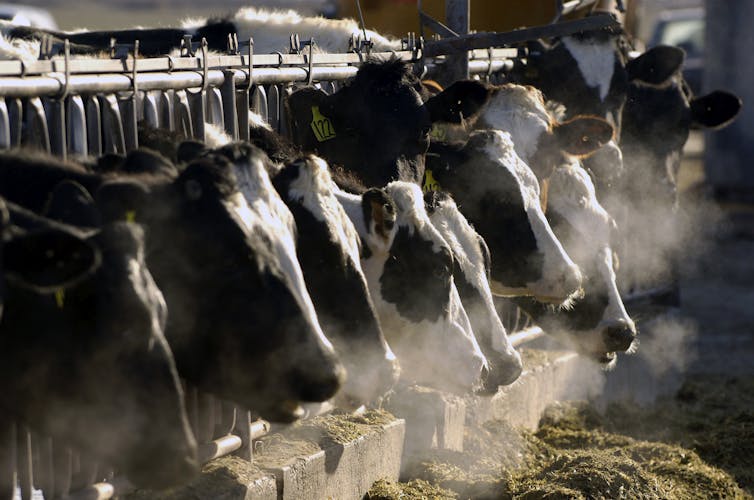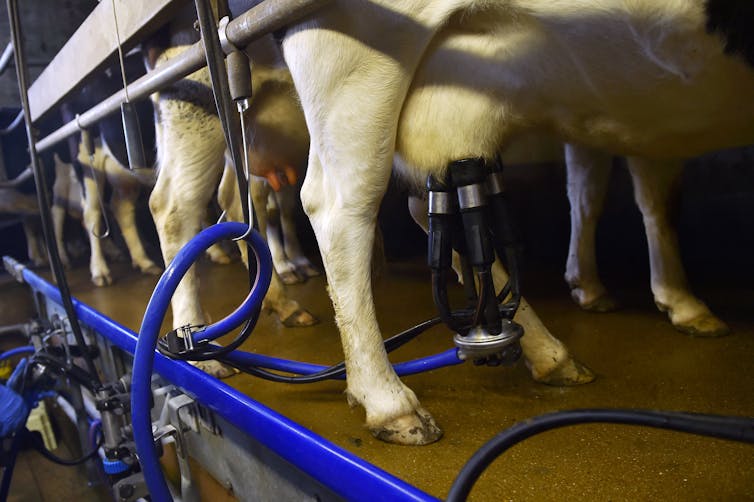Cows typically get over avian flu in a couple of weeks, but it’s an economic blow for farms.
Noelia Silva del Rio, University of California, Davis; Richard V. Pereira, University of California, Davis; Robert B. Moeller, University of California, Davis; Terry W. Lehenbauer, University of California, Davis, and Todd Cornish, University of California, Davis
The discovery of viral fragments of avian flu virus in milk sold in U.S. stores suggests that the H5N1 virus may be more widespread in U.S. dairy cattle than previously realized.
The Food and Drug Administration was quick to stress on April 24, 2024, that it believes the commercial milk supply is safe. However, highly pathogenic avian influenza virus can make cows sick, and the flu virus’s presence in herds in several states and now new federal restrictions on the movement of dairy cows between states are putting economic pressure on farmers.
Five experts in infectious diseases in cattle from the University of California, Davis – Noelia Silva del Rio, Terry Lehenbauer, Richard Pereira, Robert Moeller and Todd Cornish – explain what the test results mean, how bird flu can spread to cattle and the impact on the industry.
What are viral fragments of avian flu, and can they pose risks to people?
It’s crucial to understand that the presence of viral fragments of H5N1 doesn’t indicate the presence of intact virus particles that could cause disease.
The commercial milk supply maintains safety through two critical measures:
-
First, milk sourced from sick animals is promptly diverted or disposed of, ensuring it does not enter the food chain.
-
Second, all milk at grocery stores is heat treated to reduce pathogen load to safe levels, mainly by pasteurization. Pasteurization has been shown to effectively inactivate H5N1 in eggs, and that process occurs at a lower temperature than is used for milk.
The viral fragments were detected using quantitative polymerase chain reaction testing, which is known for its exceptional sensitivity in detecting even trace amounts of viral genetic material. These fragments are only evidence that the virus was present in the milk. They aren’t evidence that the virus is biologically active.
To evaluate whether the presence of the viral fragments corresponds to a virus with the capacity to replicate and cause disease, a different testing approach is necessary. Tests such as embryonated egg viability studies allow scientists to assess the virus’s ability to replicate by injecting a sample into an embryonated chicken egg. That type of testing is underway.
On April 24, 2024, the FDA said it had found no reason to change its assessment that the U.S. milk supply is safe. The agency does strongly advise against consuming raw milk and products derived from it because of its inherent risks of contamination with harmful pathogens, including avian flu viruses.
How does an avian flu virus get into cow’s milk?
Currently, cows confirmed to have H5N1 have different symptoms than the typical flu-like symptoms observed in birds.
Abnormal milk and mastitis, an inflammatory response to infection, are common. While there is speculation that other bodily secretions, such as saliva, respiratory fluids, urine or feces, may also harbor the virus, that has yet to be confirmed.
Milking equipment can help viruses spread.
How waterfowl or other birds transmitted H5N1 to cattle is still under investigation. In 2015, an outbreak of highly pathogenic avian influenza in commercial poultry farms reached its peak in April and May, the same time birds migrated north. Birds can shed the virus through their oral, nasal, urine and fecal secretions. So the virus could potentially be transmitted through direct contact, ingesting contaminated feed or water, or inhaling the virus.
Infected dairy cows can shed the virus in milk, and they likely can transmit it to other cows, but that still needs to be proven.
Contagious pathogens that cause mastitis can be transmitted through milking equipment or contaminated milker’s gloves. Ongoing research will help determine whether this is also a potential transmission route for H5N1, and if so, what makes the virus thrive on mammary tissue.
If H5N1 is found to be widespread in milk, what risks can that pose for the dairy industry?
For the dairy industry, infection of cattle with H5N1 avian influenza virus creates challenges at two levels.
The overriding concern is always for the safety and healthfulness of milk and dairy products.
Existing state and federal regulations and industry practices require sick cows or cows with abnormal milk to be segregated so that their milk does not enter the food supply. Proper pasteurization should kill the virus so that it cannot cause infection.
The American Association of Bovine Practitioners has also developed biosecurity guidelines for H5N1, focusing on key practices. These include minimizing wild birds’ contact with cattle and their environment, managing the movement of cattle between farms, isolating affected animals, avoiding feeding unpasteurized (raw) colostrum or milk to calves and other mammals, and ensuring the use of protective personal equipment for animal caretakers.
The other major concern is for the health of the dairy herd and the people who take care of the dairy cattle. A farm worker who handled dairy cows contracted H5N1 in Texas in March 2024, but such cases are rare.
No vaccines or specific therapies are available for avian influenza infections in dairy cattle. But following good sanitation and biosecurity practices for both people and cows will help to reduce risk of exposure and spread of the avian influenza virus among dairy cattle.
For cows that get the virus, providing supportive care, including fluids and fever reducers as needed, can help them get through the illness, which can also cause loss of appetite and affect their milk production.
Dairy farms facing an outbreak will have economic losses from caring for sick animals and the temporary reduction in milk sales. Approximately 5% to 20% of the animals in the affected herds have become ill, according to early estimates. Affected animals typically recover within 10 to 20 days.
At least 21 states have restricted importing dairy cattle to prevent the virus’s spread, and the federal government announced it will require that lactating dairy cattle be tested before they can be moved between states starting April 29, 2024. While the overall impact on U.S. milk production is projected to be minor on an annual basis, it could lead to short-lived supply disruptions.
How worried should people be about avian flu?
The federal government’s monitoring and food safety measures, along with pasteurization, provide important safeguards to protect the public from potential exposure to avian influenza virus through the food chain.
Drinking raw milk, however, does represent a risk for exposure to multiple diseases, including H5N1. This is why the FDA and Centers for Disease Control and Prevention strongly recommend drinking only pasteurized milk and dairy products.
Noelia Silva del Rio, Associate Specialist in Cooperative Extension, Production Medicine and Food Safety, University of California, Davis; Richard V. Pereira, Associate Professor of Veterinary Medicine and Associate Agronomist, University of California, Davis; Robert B. Moeller, Professor of Veterinary Medicine, University of California, Davis; Terry W. Lehenbauer, Professor of Veterinary Medicine, University of California, Davis, and Todd Cornish, Professor of Veterinary Medicine, University of California, Davis
This article is republished from The Conversation under a Creative Commons license. Read the original article.
































































